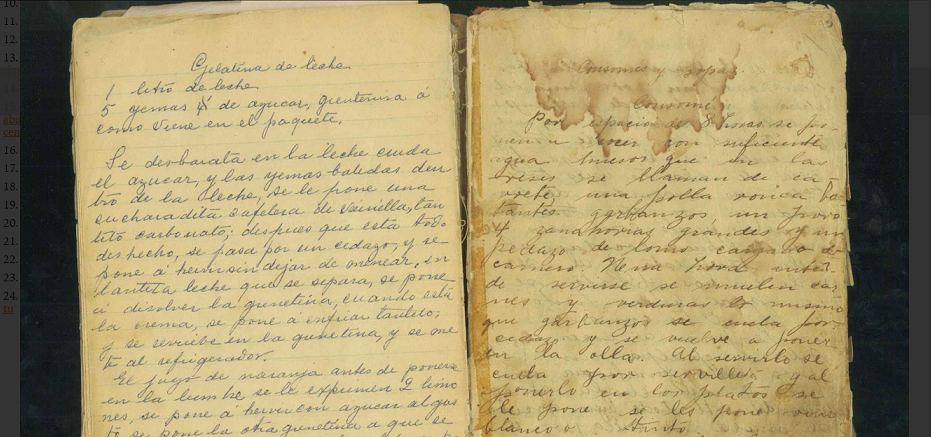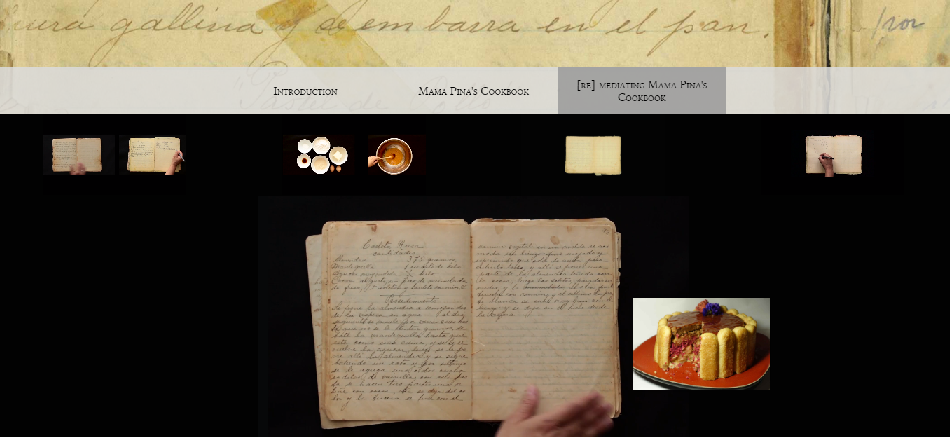[RE] ACTIVATE Mama Pina’s Cookbook
[Re] Activate Mama Pina’s Cookbook. http://www.criticalmediartstudio.com/RemediatingMamaPina/index.html. Created and maintained by Gabriela Aceves Sepúlveda. Reviewed Feb. 3, 2019.
The purpose of [Re] Activate Mama Pina’s Cookbook is to center domestic practices as something worthy of study but is rarely found in the archives. The creator wants to show how these records are a part of history, tell a story and that people today can relate and interact with it. She uses both the artifact and art to highlight the importance of women as agents and creators of history. So, while it centers on this particular cookbook, its larger aim is to address the absence of women and traditionally women’s domestic roles in archives. It was originally an installation which was then turned into a webpage.
The cookbook was started by author’s great grandmother in Mexico. It was then passed down to the author’s grandmother and her sister, and then to her mother. The cookbook represents three generations of women. In addition to the recipes, the book contains, knitting instructions and calligraphy exercises. This cookbook shows a glimpse into domestic life and economies of the time. As she notes in the introduction, and can be viewed by flipping through the pages, the book is stained with grease and old food and occasionally a drawing or doodle accompanies the recipe. Also, some recipes call for ingredients that are no longer available or measurements that would not make sense outside of that place and time.

The website offers a clear and informative introduction. The author describes her project and what she hopes to accomplish. She describes the physical characteristics of the cookbook in great detail. Next, she outlines the art portion, or the [re]mediating, of the project and how she accomplished this. First, she invited fifty people to respond to a selection of pages from the cookbook. These she displayed along with her own videos she made in response, such as cooking a dish from the cookbook while her mother read the recipe aloud through Skype. The viewers, during the installation and on the website, can respond to the videos on a blank digital page. The image lasts only ten seconds before it disappears, simulating “the absences of the archived record and the instability of digital technologies.” Visitors to the site can also interact with a digitized version of the cookbook itself. There is a separate link for each page so finding different recipes or knitting projects is easy.

This image shows how users can see the videos and images created in response to Mama Pina’s Cookbook.
This page is a great example of the different ways people are beginning to rethink what is worthy of study and what is important to archive. The author shows that there are things to learn from non-traditional materials. The site seems to be designed for the general public and public historians. It is a way to present history that engages the audience and encourages them to participate and move around the site, in ways not possible in print. By presenting the responses the author received users see how artifacts and history “speak” to different people and a digital platform allows for more creativity. This is important for public historians whose audience is broad and often diverse. Many people could connect and relate to this cookbook and even more, there are ways in which historians can utilize it as well.
Some of the difficulties with this site are navigational. In the [Re] mediating section, the videos were not searchable or scrollable. When they popped up the user had to click it but could not return to it once it was over. If one wanted to see the video or photos again, they would have to navigate away from the page and return and watch, or manually skip, all the previous videos before coming to the one desired. This presents a challenge because it requires a lot of time to get through all the videos. The responses at the end of the loop probably do not get viewed very much. As an installation, this does not seem as much of a problem because people will watch a couple then move on and others will continue the viewing. On a website, though, it would be better to be able to move through the videos more easily.
One Comment
Maeve Kane
Do you think this is more of an archival or narrative/exhibit piece, and does the distinction between the two matter for a project like this?